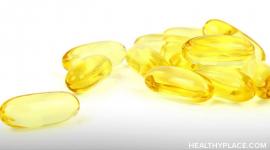S-Adenosylmethionine (SAMe)

Covers SAMe, a natural treatment of depression, Alzheimer's Disease, and fibromyalgia. Learn about the usage, dosage, side-effects of SAMe.
- Overview
- Uses
- Dietary Sources
- Available Forms
- How to Take It
- Precautions
- Possible Interactions
- Supporting Research
Overview
S-Adenosylmethionine (SAMe) is a naturally occurring compound that is involved in many biochemical processes in the body. SAMe plays a role in the immune system, maintains cell membranes, and helps produce and break down brain chemicals such as serotonin, melatonin, and dopamine as well as vitamin B12. SAMe also participates in the making of genetic material, known as DNA, and cartilage. Low amounts of folate (vitamin B9) in the body may lead to reduced levels of SAMe.
Numerous scientific studies indicate that SAMe may be useful in the treatment of depression, osteoarthritis, fibromyalgia, and liver disorders. Although it has been available in Europe by prescription for a number of years, SAMe was only recently introduced as a dietary supplement in the United States.
SAM-e Uses
SAMe offers a variety of potential therapeutic uses, primarily in the treatment of the health conditions listed below. It is important to note that SAMe has not been tested carefully over long periods of time. For this reason, it is not yet known whether using SAMe for an extended length of time (months or years) is safe.
SAM-e for depression
Preliminary research suggests that SAMe is more effective than placebo in treating mild to moderate depression and is just as effective as anti-depressant medications without the side affects frequently associated with the medications (headaches, sleeplessness and sexual dysfunction). Plus, antidepressants tend to take six to eight weeks to begin working, while SAMe seems to begin much more quickly than that.
More research regarding the safety and effectiveness of SAMe, especially for longer periods of time, is needed. It is not clear exactly how SAMe works to relieve depression, so it is best to avoid using SAMe together with other antidepressants. In addition, given the serious nature of this mood disorder, professional help should be sought for symptoms of depression before taking SAMe or any substance.
Osteoarthritis
Laboratory and animal studies suggest that SAMe may reduce pain and inflammation in the joints as well as promote cartilage repair, but researchers are not clear about how or why this works. Clinical trials with people (although generally small in size and of short duration) have also shown favorable results for SAMe when used to relieve osteoarthritis symptoms. In several short-term studies (ranging from 4 to 12 weeks), SAMe supplements were as effective as NSAIDs (nonsteroidal anti-inflammatory drugs) in adults with knee, hip, or spine osteoarthritis. SAMe was equivalent to the medications in diminishing morning stiffness, decreasing pain, reducing swelling, improving range of motion, and increasing walking pace. Several of the studies also suggest that SAMe has fewer side effects than NSAIDs.
Fibromyalgia
From studies comparing SAMe to placebo, this supplement seems to improve pain, fatigue, morning stiffness, and mood in those with fibromyalgia.
Liver Disease
Results of several animal studies suggest that SAMe may be beneficial in treating various liver disorders, particularly liver damage caused by excessive alcohol consumption. Animal studies also suggest that SAMe may protect the liver from damage after acetaminophen overdose (a pain-relieving medication purchased without a prescription). A study of 123 men and women with alcoholic liver cirrhosis (liver failure) found that SAMe treatment for 2 years may improve survival rates and delay the need for liver transplants more effectively than placebo. Although the results of this study are encouraging, more clinical trials are needed to determine whether SAMe is safe and effective for the prevention and/or treatment of liver disease.
SAM-e for Alzheimer's Disease
Studies suggest that people with Alzheimer's Disease (AD) have low levels of SAMe in the brain and that supplementation can actually increase those levels. While it has been reported that some individuals with AD have improved cognitive function from SAMe supplementation, well-designed research studies are needed to determine whether this supplement is truly safe and effective for people with the disease.
Other
Although it is premature to tell if these are safe or appropriate uses for SAMe, some early research has looked at the relationship between SAMe and Parkinson's disease, migraine headaches, Sjogrens disorder (which causes pain in connective tissue), attention deficit/hyperactivity disorder (ADHD) in adults, and vascular disorders such as heart disease.
SAMe levels may be low in people with Parkinson's and heart disease. However, experiments in rats have indicated that SAMe supplements may actually cause Parkinson's disease in these animals.
Given SAMe's structure, some have raised concern about the potential for SAMe to increase homocysteine levels. (Homocysteine has been shown to contribute to the development of plaques in the blood vessels). However, early information suggests that SAMe may actually lower homocysteine. Research is needed to know whether taking SAMe supplements may reduce homocysteine and reduce one's chances of getting heart disease.
A preliminary study of 124 migraine sufferers suggests that SAMe may decrease the frequency, intensity, and duration of headaches as well as lead to an improved sense of well being and use of fewer pain killers.
Dietary Sources for SAM-e
SAMe is not found in food. It is produced by the body from ATP and the amino acid methionine. (ATP serves as the cell's major energy source and drives a number of biological processes including muscle contraction and the production of protein).
Available Forms of SAM-e
- S-adenosylmethionine butanedisulfonate
- S-adenosylmethionine disulfate ditosylate
- S-adenosylmethionine disulfate tosylate
- S-adenosylmethionine tosylate
It is important to purchase enteric-coated tablets packaged in foil or foil blister packs. SAMe should be stored in a cool, dry place, but not refrigerated. Tablets should be kept in the blister pack until the time of ingestion.
How to Take SAM-e
Starting with a low dose (for example 200 mg per day) and increasing slowly helps avoid upset to the digestive system.
It is important to note that many of the studies evaluating SAMe for the conditions mentioned have tested injectable, not oral, forms of SAMe. Therefore, the reliability and effectiveness of oral SAMe is not entirely clear. Look for enteric-coated tablets as these are more stable and may be more dependable in terms of the amount of SAMe in the pill.
Pediatric
There are no known scientific reports on the pediatric use of SAMe. Therefore, it is not currently recommended for children.
Adult
Recommended doses of SAMe vary depending on the health condition being treated. The following list provides guidelines for the most common uses:
- depression: The majority of studies have used between 800 and 1,600 mg of SAMe per day for depression. The daily dosage is typically split between morning and afternoon.
- Osteoarthritis: A dosage of 600 mg (200 mg three times per day) for the first two weeks and then 400 mg (200 mg twice per day) for another 22 weeks has shown improvement in symptoms of osteoarthritis. Another study demonstrated improvement using 1,200 mg (400 mg three times per day) for 30 days.
- Fibromyalgia: A dosage of 800 mg per day for six weeks was shown to improve symptoms.
- Alcoholic liver disease: 800-1,200 mg per day orally in divided doses for six months enhances liver function. For liver disease, SAMe should be administered with the supervision of a qualified health care provider. This is because SAMe is administered intravenously.
Precautions
Because of the potential for side effects and interactions with medications, dietary supplements should be taken only under the supervision of a knowledgeable healthcare provider.
The safety of SAMe has not been fully assessed in children or women who are pregnant or nursing. For this reason, these groups of people should avoid SAMe. Side effects may include dry mouth, nausea, flatulence, diarrhea, headache, anxiety, a feeling of elation, restlessness, and insomnia. For this reason, SAMe should not be taken at night.
People with bipolar disorder (manic-depression) should not take SAMe since it may worsen manic episodes. SAMe should not be combined with different antidepressants without first consulting a health care provider.
People taking SAMe should supplement its use with a multivitamin that contains folic acid and vitamins B12 and B6.
Possible Interactions
If you are currently being treated with any of the following medications, you should not use SAMe without first talking to your healthcare provider.
SAM-e and antidepressant medications
There have been reports of SAMe interacting with antidepressant medications and increasing the potential for side effects including headache, irregular or accelerated heart rate, anxiety, and restlessness. On the other hand, because it often takes up to six or eight weeks for antidepressant medications to start working, SAMe has been used with certain drugs to relieve symptoms more quickly. Consult your healthcare provider before using SAMe if you are taking any medications for depression.
Supporting Research
Abittan CS, Lieber CS. Alcoholic liver disease. Curr Treat Options Gastroenterol. 1999;2(1):72-80.
Anonymous. SAMe for depression. Med Lett Drugs Ther. 1999;41(1065):107-108.
Baldessarini RJ. Neuropharmacology of S-adenosyl-L-methionine. Am J Med. 1987;83(5A):95-103.
Bell KM, et al. S-adenosylmethionine blood levels in major depression: changes with drug treatment. Acta Neurol Scand Suppl. 1994;154:15-8.
Berlanga C, Ortega-Soto HA, Ontiveros M, Senties H. Efficacy of S-adeno-L-methionine in speeding the onset of action of imipramine. Psychiatry Res. 1992;44(3):257-262.
Bottiglieri T. Folate, vitamin B12, and neuropsychiatric disorders. Nutr Rev. 1996;54(12):382-390.
Bottiglieri T, Godfrey P, Flynn T, Carney MWP, Toone BK, Reynolds EH. Cerebrospinal fluid S-adenosylmethionine in depression and dementia: effects of treatment with parental and oral -adenosylmethione. J Neurol Neurosurg Psychiatry. 1990;53:1096-1098.
Bottiglieri T, Hyland K, Reynolds EH. The clinical potential of ademetionine (S-adenosylmethionine) in neurological disorders. Drugs. 1994;48(2):137-152.
Bradley JD, Flusser D, Katz BP, Schumacher HR, Jr., Brandt KD, Chambers MA, et al. A randomized, double blind, placebo controlled trial of intravenous loading with S-adenosylmethionine (SAM) followed by oral SAM therapy in patients with knee osteoarthritis. J Rheumatol. 1994;21(5):905-911.
Bray GP, Tredger JM, Williams R. S-adenosylmethionine protects against acetaminophen hepatotoxicity in two mouse models. Hepatotol. 1992;15(2):297-301.
Bressa GM. S-adenosylmethionine (SAMe) as antidepressant: meta-analysis of clinical studies. Acta Neurol Scand Suppl. 1994;154:7-14.
Carney MW, et al. The switch mechanism and the bipolar/unipolar dichotomy. Br J Psychiatry. 1989;154:48-51.
Carney MW, Toone BK, Reynolds EH. S-adenosylmethionine and affective disorder. Am J Med. 1987;83(5A):104-106.
Chavez M. SAMe: S-Adenosylmethionine. Am J Health Syst Pharm. 2000;57(2):119-123.
Cheng H, Gomes-Trolin C, Aquilonius SM, et al. Levels of L-methionine S-adenosyltransferase activity in erythrocytes and concentrations of S-adenosylmethionine and S-adenosylhomocysteine in whole blood of patients with Parkinson's disease. Exp Neurol. 1997;145(2 Pt 1):580-585.
Cohen BM, et al. S-adenosyl-L-methionine in the treatment of Alzheimer's Disease. J Clin Psychopharmacol. 1988;8:43-47.
ConsumerLab.com. Product review: SAMe. 2000. Accessed at http://www.consumerlabs.com/results/same.asp on March 20, 2002.
Cooney CA, Wise CK, Poirer LA, Ali SF Methylamphetamine treatment affects blood and liver S-adenosylmethionine (Sam) in mice. Correlation with dopamine depletion in the striatum. Ann N Y Acad Sci. 1998;844:191-200.
di Pavoda C. S-adenosylmethionine in the treatment of osteoarthritis. Review of clinical studies. Am J Med. 1987;83(suppl 5A):60-65.
Fava M, Giannelli A, Rapisarda V, Patralia A, Guaraldi GP. Rapidity of onset of the antidepressant effect of parenteral S-adenosyl-L-methionine. Psych Res. 1995;56(3):295-297.
Fava M, Rosenbaum JF, MacLaughlin R, Falk WE, Pollack MH, Cohen LS, et al. Neuroendocrine effects of S-adenosyl-L-methionine, a novel putative antidepressant. J Psychiatric Res. 1990;24(2):177-184.
Fetrow CW, Avila JR. Efficacy of the dietary supplement S-adenosyl-L-methionine. Ann Pharmacother. 2001;35(11):1414-1425.
Fugh-Berman A, Cott JM. Dietary supplements and natural products as psychotherapeutic agents. Psychosom Med. 1999;61:712-728.
Gaby AR. Natural treatments for osteoarthritis. Alt Med Rev. 1999;4(5):330-341.
Gatto G, Caleri D, Michelacci S, Sicuteri F. Analgesizing effect of a methyl donor (S-adenosylmethionine) in migraine: an open clinical trial. Int J Clin Pharmacol Res. 1986;6:15-17.
Glorioso S, et al. Double-blind multicentre study of the activity of S-adenosylmethionine in hip and knee osteoarthritis. Int J Clin Pharmacol Res. 1985;5:39-49.
Iruela LM, Minguez L, Merino J, Monedero G. Toxic interaction of S-adenosylmethionine and clomipramine. Am J Psychiatry. 1993;150:3.
Jacobsen S, Danneskiold-Samsoe B, Andersen RB. Oral S-adenosylmethionine in primary fibromyalgia. Double-blind clinical evaluation. Scand J Rheumatol. 1991;20:294-302.
Konig B. A long term (two years) clinical trial with S-adenosylmethionine for the treatment of osteoarthritis. Am J Med. 1987;83(5A):89-94.
Laudanno GM. Cytoprotective effect of S-adenosylmethionine compared with that of misoprostol against ethanol-, aspirin-, and stress-induced gastric damage. Am J Med. 1987;83(5A):43-47.
Leventhal LJ. Management of fibromyalgia. Ann Intern Med. 1999;131:850-858.
Lieber CS. Hepatic, metabolic, and nutritional disorders of alcoholism: from pathogenesis to therapy. Crit Rev Clin Lab Sci. 2000;37(6):551-584.
Lieber CS. Role of oxidative stress and antioxidant therapy in alcoholic and nonalcoholic liver diseases. [Review]. Adv Pharmacol. 1997;38:601-628.
Loehrer FMT, Angst CP, Haefeli WE, et al. Low whole blood S-adenylmethionine and correlation between 5-methyltetrahydrofolate and homocysteine in coronary artery disease. Arterioscler Thromb Vasc Biol. 1996;16:727-733.
Loguercio C, Nardi G, Argenzio F, et al. Effect of S-adenosyl-L-methionine administration on red blood cell cysteine and glutathione levels in alcoholic patients with and without liver disease. Alcohol Alcohol. 1994;29(5):597-604.
Maccagno A, di Giorio EE, Caston OL, Sagasta CL. Double-blind controlled clinical trial of oral S-adenosylmethionine versus piroxicam in knee osteoarthritis. Am J Med. 1987;83(suppl 5A):72-77.
Mato JM, Camara J, Fernandez de Paz J. S-adenosylmethionine in alcoholic liver cirrhosis: a randomized, placebo-controlled, double-blind, multicenter clinical trial. J Hepatol. 1999;30:1081-1089.
Morelli V, Zoorob RJ. Alternative therapies: Part 1. depression, diabetes, obesity. Am Fam Phys. 2000;62(5):1051-1060
Morrison LD, Smith DD, Kish SJ. Brain S-adenosylmethione levels are severely decreased in Alzheimer's Disease. J Neurochem. 1996;67:1328-1331.
Mueller-Fassbender H. Double-blind clinical trial of s-adenosylmethionine versus ibuprofen in the treatment of osteoarthritis. Am J Med. 1987;83(suppl 5A):81-83.
SAMe for depression. Med Letter. 1999;41(1065):107-108.
Shekim WO, Antun F, Hanna GL, McCracken JT, Hess EB. S-adenosyl-L-methionine (SAM) in adults with attention deficit/hyperactivity disorder (ADHD): preliminary results from an open trial. Psychopharmacol Bull. 1990;26(2):249-253.
Shils ME, Olson JA, Shike M, eds. Modern Nutrition in Health and Disease. 9th ed. Media, Pa: Williams & Wilkins; 1999.
Tavoni A, Vitali C, Bombardieri S, Pasero G. Evaluation of S-adenosylmethionine in primary fibromyalgia. A double-blind crossover study. Am J Med. 1987 Nov 20;83(5A):107-110.
Vendemiale G, et al. Effects of oral S-adenosylmethionine on hepatic glutathione in patients with liver disease. Scand J Gastroenterol. 1989;24:407-415.
Vetter G. Double-blind comparative clinical trial with S-adenosylmethionine and indomethacin in the treatment of osteoarthritis. Am J Med. 1987;83(suppl 5A):78-80.
Young SN. The use of diet and dietary components in the study of factors controlling affect in humans: a review. J Psychiatr Neurosci. 1993;18(5):235-244.
The publisher does not accept any responsibility for the accuracy of the information or the consequences arising from the application, use, or misuse of any of the information contained herein, including any injury and/or damage to any person or property as a matter of product liability, negligence, or otherwise. No warranty, expressed or implied, is made in regard to the contents of this material. No claims or endorsements are made for any drugs or compounds currently marketed or in investigative use. This material is not intended as a guide to self-medication. The reader is advised to discuss the information provided here with a doctor, pharmacist, nurse, or other authorized healthcare practitioner and to check product information (including package inserts) regarding dosage, precautions, warnings, interactions, and contraindications before administering any drug, herb, or supplement discussed herein.
APA Reference
Staff, H.
(2008, December 21). S-Adenosylmethionine (SAMe), HealthyPlace. Retrieved
on 2025, December 31 from https://www.healthyplace.com/alternative-mental-health/supplements-vitamins/s-adenosylmethionine-same



